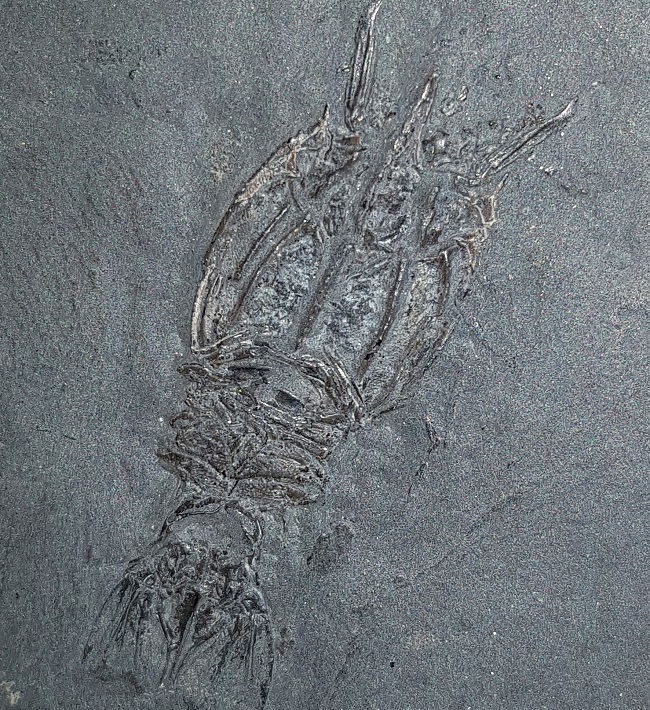Weegie scampi: Discovery of ancient Glaswegian shrimp fossil unveils new species
Published: 8 May 2024
The newly identified species of shrimp was named Tealliocaris weegie in honour of the people of Glasgow.

A short but robust little shrimp may have died out over 330 million years ago during the Carboniferous period, but the rare Scottish shellfish has been revitalised as a new species to science and as a Glaswegian.
The fossil shrimp has been given the scientific name Tealliocaris weegie thanks to a scientific paper by Dr Neil Clark of The Hunterian, University of Glasgow and Dr Andrew Ross of National Museums Scotland, identifying it forever as a Glaswegian crustacean.
The paper by Dr Clark and Dr Ross was recently published in the Royal Society of Edinburgh’s journal Earth and Environmental Science Transactions.
The little shrimp was swimming in the Carboniferous seas (now fossilised in shales) around Glasgow 333 million years ago. It was found at the world-famous fossil locality from which the Bearsden Shark was excavated in the early 1980s. Both the Bearsden Shark and an example of the shrimp can be seen on display at The Hunterian, University of Glasgow.
The Glaswegian shrimp was originally thought to be a variant of another species but is now known to belong to a different genus, which meant it had to be given a new name. The authors thought that it would be appropriate to name the new species in honour of the people of Greater Glasgow and in the local dialect.
Dr Neil Clark, Curator of Palaeontology at the University of Glasgow's Museum, The Hunterian, said: “It is quite rare that any fossil is recognised as a new species and particularly the fossilised remains of a shrimp. I am especially proud, as a Glaswegian myself, that we were able to name a fossil shrimp Tealliocaris weegie. Named after the people of Glasgow, this must surely be one of the oldest ‘Weegies’ at over 330 million years old.”
Professor Rob Ellam FRSE, Emeritus Professor at the University of Glasgow and Editor of the Transactions journal said: “This new species of fossil crustacean is basically a tiny fossil version of what we eat as scampi today.
“This paper goes to show that there is still great science to be done with fossils that can be discovered on our own doorstep.
“Moreover, naming one of the new species T. weegie shows that there is still room in the serious world of professional palaeontology and scientific publishing for a welcome bit of light-hearted Glaswegian banter.”
Dr Andrew Ross, Principal Curator of Palaeobiology at National Museums Scotland, said: “This new species of crustacean, along with others collected recently from the Scottish Borders, now in the collections of National Museums Scotland, add to our knowledge of life at the beginning of the Carboniferous, 350-330 million years ago, when back-boned animals were starting to colonise the land."
The preservation of the fauna from the shales at Bearsden and from localities of the same age around Greater Glasgow is exceptional. In some cases, the muscles and blood vessels can be seen in the partially decayed bodies of the shrimps as a result of being preserved in phosphates.
Bacterial decay of the shrimps in anoxic conditions has promoted the replacement of the soft tissues by calcium phosphate. This very rare form of preservation can be found in deposits known as Konservat Lagerstätte (a fossiliferous deposit in which there is unusual preservation of the fossils).
These shrimps, fish, sharks, and other animals lived in an equatorial lagoon when Scotland straddled the equator around 330 million years ago. The exceptional preservation suggests that the depths of the lagoon were anoxic (low in oxygen) thus preventing scavengers from destroying the remains and allowing the fossils to remain intact through the millions of years before being excavated.
Many of the fossils were excavated at Bearsden in the early 1980s by the famous Scottish fossil collector Mr Stan Wood while he was working with The Hunterian at the University of Glasgow. Some of his best discoveries from the Bearsden excavation can still be seen on display in the Hunterian Museum, including a specimen of the newly named Tealliocaris weegie and the more famous Bearsden Shark.
First published: 8 May 2024
<< May
Related Links
- Dr Neil Clark
- The Hunterian
- The Royal Society of Edinburgh
- National Museums Scotland
- Full Scientific Paper on Tealliocaris Weggie

